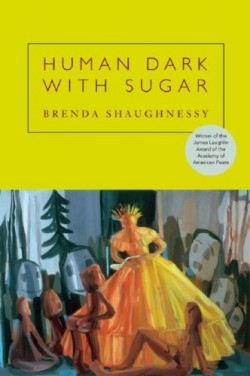Human Dark with Sugar
Surrealism began almost a century ago as very much a man’s movement, but poets like Brenda Shaughnessy have recently adapted many surrealist techniques for purposes that are distinctly womanly and all their own. Human Dark with Sugar is sometimes confessional, sometimes speculative, sometimes wistful, but always energetic and often moving.
Shaughnessy, poetry editor of Tin House magazine, earlier published Interior with Sudden Joy (1999). Her second book of poems begins with the frankly sexual “I’m Over the Moon.” One might imagine that there are no new ways to connect the moon and love, but has anyone ever called it “A kind of ancient / date rape drug?” Here and throughout, Shaughnessy riffs recklessly around familiar metaphors and situations, finding fresh angles and—always—plenty of attitude. “Parthenogenesis” turns out to be about anorexia, or at least about the way women in America are forced to contend endlessly with their appetites: “For me, starving, that coreless, useful feeling, / is not making myself smaller // but making myself bigger, inside.”
Brash and tender images commingle in this book, often with a trademark profligacy that flirts with the absurd. Early in the long poem “One Love Story, Eight Takes” Shaughnessy’s reckless speaker describes a dress “so extravagantly feminine / you could see my ovaries through it.” Yet the poem ends quietly, with much plainer language and apparent remorse: “To see you again, isn’t love revision? / It could have gone so many ways.”
Shaughnessy sometimes requires a considerable suspension of suspicion. In “Why Is the Color of Snow?” she asks ““Don’t we melt it? / Aren’t we human dark with sugar hot to melt it?” The first question seems easy enough, but the second is hard to parse in any very plausible way. And the poem slides into even less plausible rhetorical questions: “If a bank of snow / is an obstruction, then what is not a bank of snow?”
These poems are best when they trace the contours of physical awareness and sexual tension; as Shaughnessy insists, stories without sex “never get picked out to read in bed.” Her sometimes nervous, sometimes exuberant eroticism connects distantly to the early surrealists, but more directly to contemporary female poets like Mary Ruefle, Larissa Szporluk, and others who have—however belatedly—claimed the right to speak boldly, if often elliptically, of bodies in the orbits of desire.
Reviewed by
Jeff Gundy
Disclosure: This article is not an endorsement, but a review. The publisher of this book provided free copies of the book to have their book reviewed by a professional reviewer. No fee was paid by the publisher for this review. Foreword Reviews only recommends books that we love. Foreword Magazine, Inc. is disclosing this in accordance with the Federal Trade Commission’s 16 CFR, Part 255.

